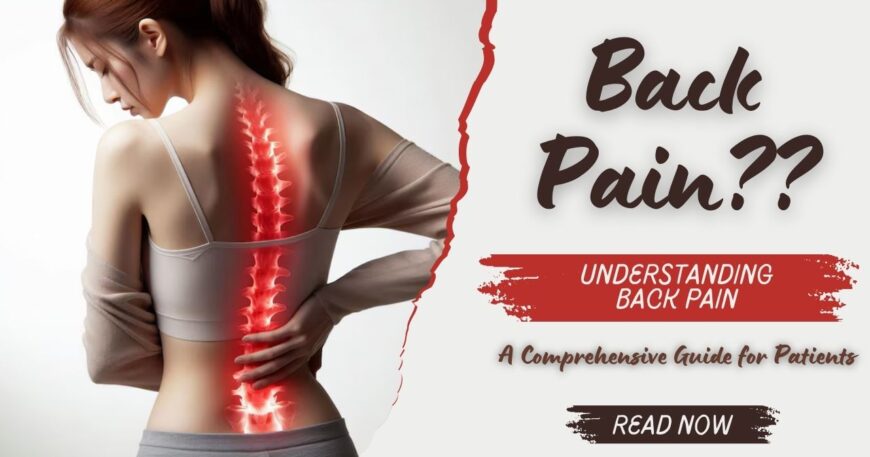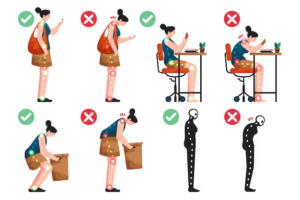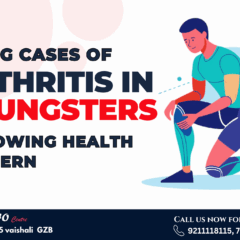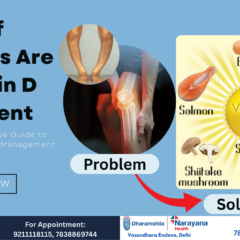
Understanding Back Pain: A Comprehensive Guide for Patients
Understanding Back Pain: A Comprehensive Guide for Patients
Back pain is a widespread issue affecting millions of people worldwide. It can range from a mild, dull ache to severe, debilitating pain that interferes with daily activities. Understanding the causes, symptoms, and treatment options is crucial for effective management. This guide aims to provide patients with comprehensive information on back pain, with a focus on prevention, treatment, and when to seek professional help.
Types of Back Pain
- Acute vs. Chronic Back Pain
- Acute Back Pain: This type of pain is usually sudden and lasts for a short period, typically less than six weeks. It often results from an injury or a strain.
- Chronic Back Pain: Pain that persists for more than three months is considered chronic. It may be constant or come and go, and it often requires a more in-depth evaluation and treatment plan.
- Postural Back Pain
- What It Is: Postural back pain is increasingly common, especially among individuals with sedentary lifestyles. Poor posture while sitting, standing, or sleeping can lead to muscle strain and discomfort.
- Prevention: Simple changes like maintaining proper posture, using ergonomic furniture, and taking frequent breaks can significantly reduce the risk of developing postural back pain.
Common Causes of Back Pain
- Muscle or Ligament Strain
- Overview: Overstretching or tearing of muscles and ligaments can lead to significant pain and stiffness.
- Causes: Lifting heavy objects improperly, sudden movements, or a fall can cause strains.
- Herniated or Bulging Discs
- Overview: The discs in the spine act as cushions between the vertebrae. A herniated or bulging disc occurs when the disc is damaged and presses on nearby nerves, causing pain.
- Symptoms: Sharp pain, numbness, or weakness in the back or legs are common symptoms.
- Arthritis
- Overview: Osteoarthritis can affect the lower back, leading to stiffness, pain, and reduced range of motion.
- Symptoms: Pain that worsens with movement, swelling, and tenderness in the affected joints.
- Osteoporosis
- Overview: This condition weakens bones, making them more susceptible to fractures. Spinal fractures can cause severe back pain.
- Prevention: Adequate calcium and vitamin D intake, along with regular exercise, can help maintain bone density.
- Spinal Stenosis
- Overview: This condition involves the narrowing of the spinal canal, which can put pressure on the spinal cord and nerves.
- Symptoms: Pain, numbness, and weakness, particularly when walking or standing.
Symptoms to Watch For
- Persistent pain that doesn’t improve with rest.
- Pain that radiates down one or both legs, possibly indicating nerve involvement.
- Weakness, numbness, or tingling in the legs or feet.
- Difficulty standing, walking, or performing daily activities.
- Severe pain following an injury, fall, or accident.
Back Pain Treatment Options
- Non-Surgical Treatments
- Physical Therapy: Tailored exercises to strengthen the muscles supporting the spine, improve flexibility, and reduce pain.
- Medications: Over-the-counter pain relievers, muscle relaxants, or anti-inflammatory drugs may be recommended.
- Lifestyle Modifications: Weight management, regular exercise, and quitting smoking can alleviate back pain.
- Heat and Cold Therapy: Applying heat or cold to the affected area can help reduce pain and inflammation.
- Interventional Treatments
- Injections: Corticosteroid injections can provide temporary relief by reducing inflammation around the nerves or joints.
- Chiropractic Care: Spinal manipulation by a qualified chiropractor can relieve pain and improve mobility.
- Surgery as the Last Option
- When to Consider Surgery: Surgery is typically reserved for cases where non-surgical treatments have failed, or when there is significant nerve compression, spinal instability, or severe injury.
- Common Surgical Procedures: Discectomy, laminectomy, and spinal fusion are some surgical options for treating severe back pain.
Preventing Back Pain

- Maintain Good Posture: Be mindful of your posture while sitting, standing, and sleeping. Use ergonomic furniture and avoid slouching.
- Stay Active: Regular exercise strengthens the muscles supporting the spine, improves flexibility, and reduces the risk of back pain.
- Lift Properly: When lifting heavy objects, use your legs to lift rather than your back. Avoid twisting while lifting.
- Weight Management: Maintaining a healthy weight reduces the strain on your back and joints.
Contact Us for Expert Care
If you are experiencing persistent back pain and are unsure about the right course of action, don’t hesitate to reach out to us at My Ortho Centre. Our team of experienced orthopedic specialists is here to provide personalized care and guide you through the best treatment options.
Contact Us: Error: Contact form not found.
Your health and well-being are our top priority. Let us help you find relief and get back to enjoying your life, pain-free.
By addressing every aspect of back pain, from prevention to treatment, patients can make informed decisions about their care. At My Ortho Centre, we are committed to providing comprehensive and compassionate orthopedic care tailored to your needs.


